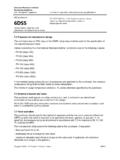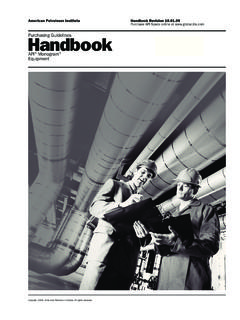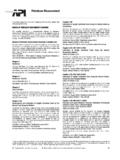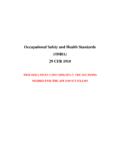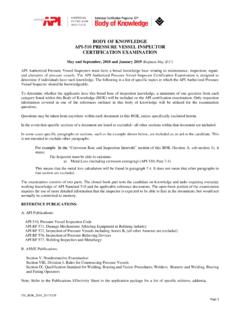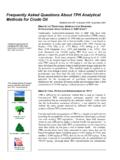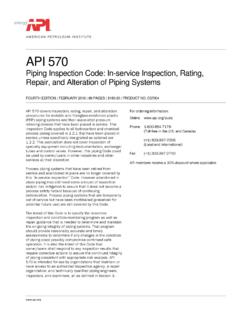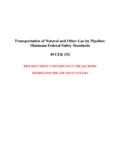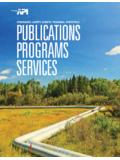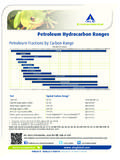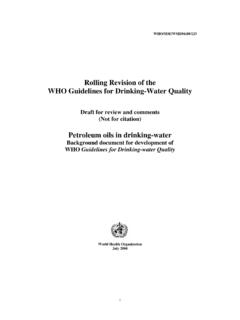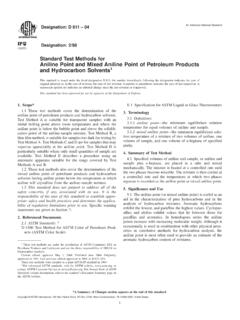Transcription of Risk-Based Methodologies for Evaluating …
1 Risk-Based Methodologies for Evaluating petroleum hydrocarbon Impacts at Oil and NaturalGas E&P Sites Regulatory and Scientific Affairs Department API PUBLICATION NUMBER 4709 FEBRUARY 2001 Risk-Based Methodologies for Evaluating petroleum hydrocarbon Impacts at Oil and NaturalGas E&P Sites Regulatory and Scientific Affairs Department API PUBLICATION NUMBER 4709 FEBRUARY 2001 PREPARED UNDER CONTRACT BY:David V. NaklesThermoRetec Consulting Corporation FOREWORD API publications necessarily address problems of a general nature. With respect to partic-ular circumstances, local, state and federal laws and regulations should be is not undertaking to meet the duties of employers, manufacturers, or suppliers towarn and properly train and equip their employees, and others exposed, concerning healthand safety risks and precautions, nor undertaking their obligations under local, state, or fed-eral contained in any API publication is to be construed as granting any right, byimplication or otherwise, for the manufacture, sale, or use of any method, apparatus, or prod-uct covered by letters patent.
2 Neither should anything contained in the publication be con-strued as insuring anyone against liability for infringement of letters patent. All rights reserved. No part of this work may be reproduced, stored in a retrieval system, or transmitted by any means, electronic, mechanical, photocopying, recording, or otherwise, without prior written permission from the publisher. Contact the Publisher, API Publishing Services, 1220 L Street, , Washington, 20005. Copyright 2001 American petroleum Institute iii ACKNOWLEDGMENTS API STAFF CONTACTH arley Hopkins, Regulatory and Scientific Affairs DepartmentThe API Production Waste Issue Group (PWIG) is acknowledged for providing funding for this would like to thank the companies that participated in the petroleum Environmental Research Forum (PERF) Project 97-08 for their permission to publish this manual:Arthur D. LittleChevron Research and Technology CompanyEquilon Enterprises LLCE xxon Mobil CorporationTexaco IncorporatedUnocal CorporationThe following individuals are acknowledged for the contributions of theirorganizations to PERF 97-08:John Harju, Gas Technology InstituteNancy Comstock, Department of EnergyAPI acknowledges the following individuals for their contributions this manual:George Deeley, Equilon Enterprises LLCSkip Dees, Texaco IncorporatedGeorge DeVaull, Equilon Enterprises LLCBill Freeman (formerly with Shell Oil Company)Wayne Hamilton, Shell Oil CompanyJill Kerr, ExxonMobil CorporationPaul Lundegard, Unocal CorporationRenae Magaw, Chevron Research and Technology CompanySara McMillen, (Chairperson PERF 97-08), Chevron Research and Technology Sedlock, (Chairperson PWIG), Chevron Research and Technology Co.
3 ViTABLE OF CONTENTSE xecutive viiPart I: 1 Purpose of Manual .. 1 Content and Organization of Manual .. 1 Part II: Risk-Based Decision Making .. 2 What Is It? ..2 Why Use It?.. 2 Traditional Approaches Not based on Risk .. 2 Traditional Approaches May Misallocate 3 Risk-Based Approaches Permit Cost-Benefit 3 Should It Be Used At All Sites?.. 3 What Are Tiered Risk-Based Decision-Making Frameworks? .. 4 When Is It Appropriate To Use a Tiered Approach? .. 5 What Is the Role of Generic Site Cleanup Criteria in the Risk-BasedDecision-Making Process? .. 6 Tier 1 versus Tier 2 or Tier 3? .. 6 Part III: Characteristics of Crude Oils, Refined petroleum Products,Condensates, and E&P Wastes .. 8 Chemical 8 What Are the Chemical Characteristics of Crude Oil and Its RefinedProducts? .. 8 Crude Oil .. 8 Refined Products .. 10 What Are the Chemical Characteristics of Condensates?
4 12 What Are the Chemical Characteristics of E&P Wastes?.. 12 Characterization 13 Characterization 14 Physical 15 What Are the Physical Properties of Hydrocarbons that Influence theirMovement in the Environment? .. 15 What Are the Nature of These Physical Properties for Crude Oil,Refined Products, Condensates, and E&P Wastes? .. 17 Crude Oil .. 17 Refined Products .. 17E&P 18 Toxicological CharacteristicsWhat Human Health Toxicity Data Are Available? .. 18 Cancer Health 19 Non-Cancer Health Effects .. 19 What Ecological Toxicity Data Are Available?.. 20 Summary of Key Differences in the Characteristics of Crude Oil, RefinedPetroleum Products, Condensates, and E&P Wastes .. 20 What Is the Evidence of Differences in Bulk hydrocarbon Composi-tion? .. 20 Carbon-Number Range .. 20 Chemical Classes of 20 API Gravity .. 22 What Is the Evidence of Differences in Specific Chemical Composi-tion?
5 22 Benzene .. 22 PAHs .. 23 Metals .. 23 Blending Agents and 24 What Is the Evidence of Differences in Mobility and Toxicity? .. 24 Toxicity .. 24 Part IV: Calculation of Risk and Risk-Based Screening Levels .. 26 What Are the Key Components of the Four Elements of the Risk Evalua-tion Process?.. 26 Hazard 26 Exposure Assessment .. 26 Toxicity (Dose-Response) Assessment .. 27 Risk Characterization .. 27 What Calculations Are Used To Determine Risks to Human Health? .. 28 Exposure Assessment: Calculation of Contaminant Intake .. 28 Derivation of Toxicological Dose-Response 28 Calculation of 29 What Are Risk-Based Screening Levels (RBSLs) and How Are TheyDerived? .. 29 Are RBSLs Identical for All Routes of Exposure? .. 31 What Are the Default Assumptions That Are Used in the RBSL Equationsand from Where Did They Originate?.. 31iiiPart V: Application of Risk-Based Methodologies to E&P Sites.
6 33 TPHCWG Risk-Based Methodology .. 33 What Is the Traditional Approach for Managing hydrocarbon -Impacted Soils at E&P Sites?.. 33 What Is Total petroleum hydrocarbon or TPH?.. 34 What Methods Are Used to Measure Bulk TPH in Soil and Ground-water? .. 34 Analytical Methods .. 35 What Does Industry Guidance Tell Us About TPH Closure Criteria? .. 36 What Are Some of the Typical TPH Closure Criteria that Have BeenUsed Internationally? .. 36 What Other Criteria Besides TPH Have Been Used for the Closure ofE&P Sites? .. 37 What Is the Role of Bulk TPH Measurements in E&P Site Manage-ment? .. 38 What Is the General Risk Assessment Approach of the TPHCWG andHow Does It Address the Shortcomings of Bulk TPH Measurements? .. 38 Cancer Risk .. 39 Non-Cancer Risk .. 39 What Basis did the TPHCWG Use To Define the Different Hydro-carbon Fractions of TPH?
7 39 How Was the Toxicity of Each hydrocarbon Fraction Assigned? .. 41 What Analytical Methodology Is Used by the TPHCWG To Quantifythese hydrocarbon Fractions? .. 41 Why Was It Necessary To Modify the TPHCWG AnalyticalMethodology To Deal with Crude Oil at E&P Sites? .. 42 How Was the TPHCWG Analytical Methodology Modified To Dealwith Crude Oils at E&P Sites? .. 42 What Portion of the Total hydrocarbon in Crude Oil Can BeCategorized Using the Modified TPHCWG (PERF) Analytical Metho-dology? .. 44 How Do the Quantity of Hydrocarbons in Each Fraction Vary AmongDifferent Crude Oil Products? .. 45 How Were the Fate and Transport Properties and ToxicologicalCharacteristics of the C35-44 and C44+ Carbon Number FractionsDetermined? .. 46C35-44 Carbon Number 46C44+ Carbon Number 46 What Are Relevant Exposure Pathways for an E&P Site?
8 47 How Are the TPH Fractionation Data Used To Calculate an RBSL forthe Whole Crude Oil?.. 48 What Exposure Scenarios and Pathways Are Important for Crude Oiland What Are the TPH RBSLs for these Situations?.. 49ivWhat Exposure Pathways and TPH Fractions Typically Dictate TPHRBSLs for Crude Oil at an E&P Site? .. 50 How Do the TPH RBSLs for Crude Oil Compare to TPH RBSLs forRefined petroleum Products, Condensates or Associated Wastes? .. 51 Refined petroleum 51 Gas Condensates .. 52 Associated 52 When Is It Necessary To Use the Risk-Based Assessment of TPHR ather than Conventional TPH Measurements or Assessments? .. 53 How Important Are the Risks Associated with Metals, PolycyclicAromatic Hydrocarbons, and Benzene in the Crude Oil? .. 54 Metals .. 54 Polycyclic Aromatic Hydrocarbons .. 55 Benzene .. 55 RBCA Tools for the E&P Industry.
9 57 Other Considerations for Overseas Applications .. 58 Has the TPHCWG Methodology Been Accepted by OverseasRegulators?.. 58 What Special Factors Should Be Considered When Preparing ToApply the TPHCWG Methodology to an International E&P Site? .. 58 Part VI: References .. 60 Appendix A E&P Wastes: Regulatory StatusAppendix B Equations for Calculation of Risk-Based Screening Levels for SoilAppendix C Consideration of hydrocarbon -Saturated Soil Conditions DuringCalculation of RBSLsvLIST OF TABLES1 Fate and Transport Characteristics of TPH Fractions ( based on EquivalentCarbon Number).. 412 Representative Toxicity of Carbon-Number Fractions .. 423 TPH RBSLs for Selected Refined Products of Crude Oil (mg/kg).. 514 TPH RBSLs for Selected Gas Condensates (mg/kg) .. 525 Non-Residential TPH RBSLs for Crude Oil and Their Associated Wastes(mg/kg).
10 536 Summary of Metals Concentrations (mg/kg Oil) in 26 Crude Oils .. 547 PAH Concentrations (mg/kg Oil) in 60 Crude Oils .. 56viLIST OF FIGURES1 Chemical Classification of petroleum Hydrocarbons .. 92 Main Groups of Chemical Compounds in Crude 93 Gas Chromatograms for Two Crude Oils .. 104 Boiling Point and Carbon Number Ranges for Six Common Crude OilProducts ..115 Gas Chromatograms of Gas Condensates .. 126 Gas Chromatographic Fingerprints of Gasoline and Diesel Fuel .. 217 Comparison of Crude Oil Composition of PERF Study Samples toWorldwide (636 crude oils) Sample Set .. 228 Carbon Number Ranges Addressed by TPH Analytical Methods .. 359 Determining TPH Composition: Separation of Chemical Groups intoCarbon Number Fractions .. 4010 Yield of Vacuum Residuum in 800 Crude Oils Produced in the UnitedStates .. 4311 Aliphatic and Aromatic Carbon Number Fractions for the Assessment ofRisk Associated with Crude Oil TPH.
